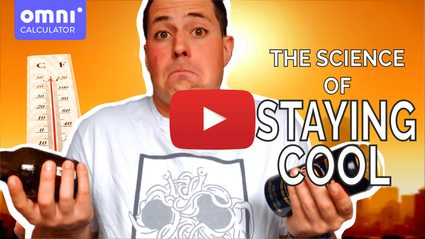Newton's Law of Cooling Calculator
How long does it take for a cup of tea to cool down? Or for a cup of coffee? The Newton's law of cooling calculator answers these kinds of questions. Reading the text below, you will learn about thermal conduction, the primary mechanism behind Newton's law of cooling. You will also find out what is Newton's law of cooling formula.
Careful with that cup of coffee, though; find out more from our coffee kick calculator.
Thermal conduction and convection
There are three main mechanisms of heat exchange: thermal conduction, convection, and radiation. Newton's law of cooling is best applicable when thermal conduction and convection are the leading processes of heat loss. An example is the cooling of a cup of tea. In such cases, the primary exchange of heat happens at the surface between the liquid and air. The warm liquid evaporates, and convection drags it away from the cup, cooling the rest of the fluid.
How fast things cool down depends on two factors. One is the difference in the temperatures between the object and the surroundings. The larger the difference, the faster the cooling. The other factor is the cooling coefficient , which depends on the mechanism and amount of heat exchanged. We can express the cooling coefficient as:
where:
- – Cooling coefficient;
- – Heat transfer coefficient;
- – Area of the heat exchange; and
- – Heat capacity.
This formula for the cooling coefficient works best when convection is small. In fact, the heat transfer in convection depends on the temperature, which makes this simple formula a bit less accurate. Here we assume that the heat transfer coefficient is constant.
Newton's law of cooling formula
Newton's law of cooling formula is:
where:
- – Temperature of the object at the time ;
- – Ambient temperature;
- – Initial temperature of the object;
- – Cooling coefficient; and
- – Time of the cooling.
For the applicability of Newton's law, it is important that the temperature of the object is roughly the same everywhere. This requires the Biot number to be small.
Speaking of Newton, did you check out our newton meter to joules converter? It is worth taking a look at.
Newton's law of cooling calculator
It is easy to apply Newton's law of cooling with our calculator. Just specify the initial temperature (let's say 100 °C), the ambient temperature (let's say 22 °C), and the cooling coefficient (for example 0.015 1/s) to find out that the temperature drops to 35 °C after 2 minutes.
In the Additional parameters section, you can enter the heat transfer coefficient, the heat capacity, and the surface area of the object. Based on this information, the calculator computes the cooling coefficient.
Interested in warming things up instead of letting them cool down? Check then the Joule heating calculator.
How do I calculate Newton's law of cooling?
To calculate Newton's law of cooling, you can use the formula:
T = T_amb + (T_initial - T_amb) × e-kt
Where:
T– Temperature of the object at the time t;T_amb– Ambient temperature;T_initial– Initial temperature of the object;k– Cooling coefficient; andt– Time of the cooling.
Can you use Fahrenheit for Newton's law of cooling?
Yes, you can use Fahrenheit for temperature measurements in Newton's law of cooling. Generally, the equation's default unit to measure temperature is °C, but you can easily convert it to °F using the conversion formula.
How do I calculate cooling rate?
In the context of Newton's law of cooling, you can determine the cooling rate by following these steps:
- Note down the temperature measurements of the object at different intervals of time.
- Note down the time elapsed during each of the temperature measurements.
- Determine the temperature difference by subtracting the initial temperature from the final temperature.
- Determine the time difference by subtracting the starting time from the ending time.
- Divide the temperature difference by the time difference.
- The result is the cooling rate of the object.
What is the law of cooling rate?
The correct way to say it is "Newton's Law of Cooling". This law uses the cooling rate to determine the rate of change of temperature of an object.
It states that "the rate of temperature change is directly proportional to the temperature difference between the object and its surroundings".
How long does it take for my 55°C coffee to cool down to 35°C?
Your hot 55°C cup of coffee will cool down to 35°C in 5 minutes if you are sitting in an air-conditioned room at 26°C, and the cooling constant is 0.0039.
